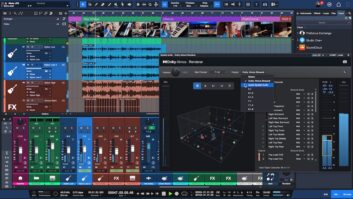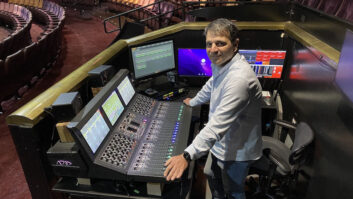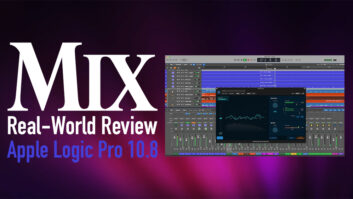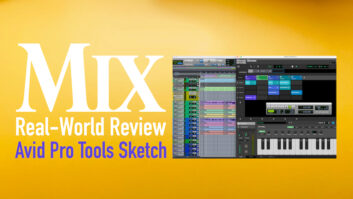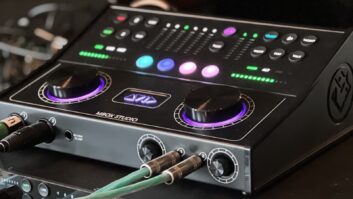
If any of the numerous rumors I’ve heard are true, April should be the month when Apple releases its long-awaited MacPro tower upgrade and Avid launches Pro Tools 11. Both companies can rest assured that pro users will treat the releases as a barometer of just how tuned in they are to our needs and how the changes will affect our wallets.
advertisement
Apple disappointed tower users last June with an update that was largely viewed as soft, with the last significant upgrade coming in 2010. The “new” towers stuck with the older Westmere processors instead of incorporating Intel’s latest Sandy Bridge E, plus there was no jump to USB 3 or Thunderbolt, which the company has been offering on its laptops since early 2011. So expectations are high that Apple will not only play catch up but also exceed expectations. But there may be reason for concern, not the least of which is that according to 9to5Mac.com, sales of Mac Pros at Apple Europe online stores was to end March 1 because of noncompliance with new regulations.
Trust from high-end users is at an ebb because of recent moves signaling that the company is moving away from pro in deference to hot consumer markets for the iPad, laptops, iPhone and a hype-speculated iWatch. Some of Apple’s recent behavior supports this argument. According to Russ Hughes of Pro Tools Expert: “The (Apple) EMEA [Europe, Middle East, and Africa] team responsible for nurturing and supporting the pro studios, post facilities and TV has gone from 12 to 2 in a matter of months.” On the software side, there hasn’t been an update of Logic Pro since mid 2009, and Apple’s Final Cut Pro X last year, which the company called a “revolution in creative editing,” was largely panned by the pro video community.
There has also been a shift in GUI philosophy heralded by the fusion of OS X and iOS, with changes that in my opinion are a move backward, making the user experience less friendly than in past upgrades. One of the more obvious: “Save As” now takes more mouse clicks. There are many more examples.
So what will the new tower bring? There are a few things I believe you can count on. There will be no optical drive, no FireWire 800 and Apple will add USB 3 and some kind of flash memory in place of a mechanical drive. The biggie for audio users is—gasp—fewer PCI slots in favor of Thunderbolt I/O. This means Apple can build a slimmer, trimmer box, but for audio pros it means added investment to get PCIe cards into and out of the computer.
So while everyone has an opinion on the best feature set for pro use, it won’t matter once the new tower comes out. Apple is Apple, and with very few exceptions, the company hasn’t backtracked once they decide on their vision of the future, no matter if you’re a consumer or pro.
Moving on to Pro Tools, there is reason to like a 64-bit proficient DAW from Avid. Especially for those using virtual instruments, large sample libraries or integrating video into their Pro Tools session workflow—it’s all about RAM. DAWs like Cakewalk, Nuendo, Cubase and SONAR have been on the 64-bit train for some time, and users expect this kind of performance. For a great look at the 64-bit plus and minus argument in detail, see Michael Cooper’s feature in the September 2012 Mix.
For most users, the main reason for a jump to 11 will be access to a larger amount of RAM. The memory limit of a 32-bit DAW is an anemic 4 GB, while the theoretical limit of a 64-bit DAW is a whopping 128 TB. It doesn’t have to be the extreme that gets you better performance: 16 GB or even 32 GB gives you a lot more power and is more affordable than ever. More memory gives you plenty of space for RAM caching a session, loading some VIs and having leftovers for other essential operations.
One concern for the wallets of users will be the death of RTAS in the new 64-bit software. AAX is backward-compatible with Pro Tools 10 for Pro Tools HD users using the new HDX card, but RTAS is going away. This is inevitable and not such a bad thing; there is a quality hit when sharing sessions between Native and DSP-powered systems using RTAS plug-ins. So overall compatibility between systems is better, plus AAX enables manufacturers to develop more powerful plug-ins.
The total price of AAX upgrades is largely unknown at this point, as there are some manufacturers still not offering upgrades and others opting for an alternative to running AAX on HDX. This is an added expense but relieves users from having to upgrade to newer Avid HD I/O for the time being as Pro Tools 11 is rumored to be a possible cutoff for backward compatibility to older I/O.
Whew! So much to think about. Like most major upgrades, you can’t please everyone, and there will be disappointments. By the time you read this, the news should all be in and there will be smart moves to be made, whether it means sticking with what you have or jumping to new and more capable systems.

